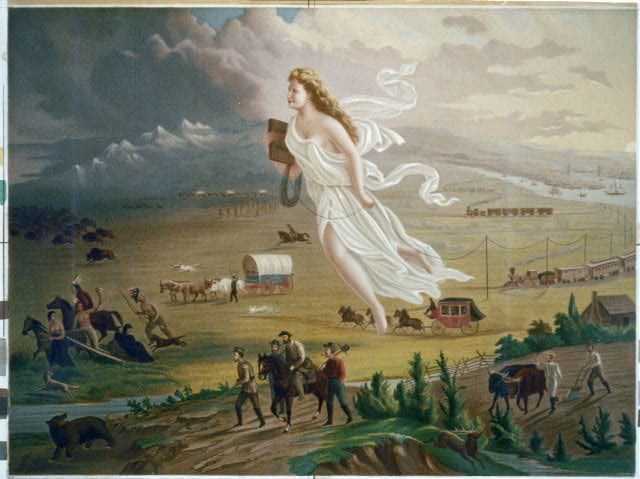American Progress, the 1872 painting by John Gast, is perhaps the most iconic portrayal of Manifest Destiny in the United States of America. Beginning with Thomas Jefferson’s Louisiana Purchase in 1803, the young nation began to turn its eyesight towards westward expansion. With America continuing to push out west and many Americans believing that God wanted them to conquer as much of the west as possible, the term Manifest Destiny was coined by John Louis O’Sullivan in 1845. Westward expansion in America was seen as a time of opportunity and second chances for some and had a plethora of outcomes and side effects, some positive and many negative.
During westward expansion in the nineteenth century Americans believed that they were divinely inspired to push as far west as possible. Many at the start of the nineteenth century felt that Americans had become God’s Chosen people with Thomas Jefferson even claiming “God led our forefathers, as Israel of old” in his Second Inaugural Speech in 1805.[1] We view the divinely inspired aspect of this piece through the angel moving west, implying this was a plan crafted by God to move westward. We see the popular traveling vessels of the time depicted in the painting with trains, steamboats, and wagons all being included in the painting, depicting the civilizing of the west, further seen by the angel carrying a schoolbook. Despite continued and vast expansion west, the American government carefully deliberated on which land to annex and which land to pass up on. Congress was hesitant to move into any land that held a large nonwhite population, instead opting to settle in uninhabited lands where they could establish a white majority. [2] The prospect of moving into the unknown is represented by the shifting light in the painting, with the East being shown in the light with the West looking rather dark. The light is moving with the angel into the West symbolizing that America is bringing their technological advancements with them to inhabit and civilize the land.
One of the main results of Manifest Destiny was the displacement of the Native Americans. As seen in the American Progress painting with the Americans moving west, the Natives and wildlife are running away, as the Americans pushing west are looking to take the land from the natives and bring with it industrialization, seen by the angel laying the telegraph wires as she continues moving west, putting an emphasis on expanding communication across America. The left half of the painting shows land that is untouched rich with nature and beautiful mountain ranges while the right shows the used up, settled land seen across the east coast at the time. The Native Americans, many of which already had been displaced due to European settlements across North America, were now seeing themselves get pushed off this land too. The passing of the Indian Removal Act in 1830 under President Jackson forced Native Americans to relocate to federal lands west of the Mississippi River. This led to Natives being displaced over the next decade, most notably the “Trail of Tears” occurring under President Van Buren between 1838 and 1839 which was the Cherokee’s 800 mile forced journey west from Georgia to Indian lands in Oklahoma.[3] The Trail of Tears not only marked the last of the Natives being pushed out of the east, but also significantly effected the Native American population with historians estimating more than 5,000 Cherokee deaths.[4]
American Progress portrays the good and the bad of Manifest Destiny. American families are moving west to seek better lives for themselves and get a fresh start, however this comes at a cost with Native Americans, nature and wildlife all paying the consequences of America’s ‘divinely inspired’ expansion west.
[1] Albert Katz Weinberg. 1979. Manifest Destiny: A Study of Nationalist Expansionism in American History. 1st AMS ed. New York: AMS Press., 40.
[2] Paul Frymer. Building an American Empire: The Era of Territorial and Political Expansion. Princeton University Press, 2017., 175-176.
[3] David Emory Shi, America: A Narrative History (New York: W.W. Norton and Company, 2022), 385–91.
[4] Author Unknown. 2015. Native Americans: Cultural Diversity, Health Issues and Challenges. Focus on Civilizations and Cultures. New York: Nova Science Publishers, Inc., 12.
